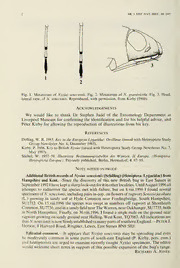
Additional British records of Nysius senecionis (Schilling) (Hemiptera: Lygaeidae) from Hampshire and Kent PDF
Preview Additional British records of Nysius senecionis (Schilling) (Hemiptera: Lygaeidae) from Hampshire and Kent
— BR.J.ENT.NAT.HIST.,10: 1997 u w Fig. 1. Metatarsus of Nysius senecionis. Fig. 2. Metatarsus of A', graminicola. Fig. 3. Head, lateral view, ofTV. senecionis. Reproduced, with permission, from Kirby (1986). Acknowledgements We would like to thank Dr Stephen Judd of the Entomology Department at Liverpool Museum for confirming the identification and for his helpful advice, and Peter Kirby for allowing the reproduction ofillustrations from his key. References Dolling,W. R. 1985. Key to theEuropeanLygaeidae: Orsillinae(issuedwith Heteroptera Study Group Newsletter No. 6, December 1985). Kirby, P. 1986. Keyto BritishNysius(issuedwith Heteroptera StudyGroup NewsletterNo. 7, May 1987). Stichel, W. 1957-59. Illustrierte Bestimmungstabellen der Wanzen. II Europa. (Hemiptera: Heteroptera Europae). Privately published, Berlin, Hermsdorf. 4: 87-95. Noteadded in proof AdditionalBritishre—cordsofNysiussenecionis(Schilling)(Hemiptera: Lygaeidae)from Hampshire and Kent. Since the discovery of this new British bug in East Sussex in September19921havekeptasharplook-outforitinotherlocalifies.UntilAugust1996all attempts to rediscover the species met with failure, but on 8.viii.l996 I found several specimensofA'^.senecionis,includingpairsin-cop,onflowersofragwortSeneciojacobaea (L.) growing in sandy soil at Hyde Common near Fordingbridge, South Hampshire, SU1712. On 15.viii.l996 the species was swept in numbers offragwort at Shortheath Coinmon,SU7736,andinasandyfieldnearTheWarren,nearOakhanger,SU7735,both in North Hampshire. Finally, on 30.viii.l996, 1 found a singlemaleon theground near ragwortgrowingonsandygroundnearHailing,WestKent,TQ7063.Allindicationsare thatA^.senecionisisnowfirmlyestablishedinmanypartsofsouthernEngland. PeterJ. Hodge, 8 Harvard Road, Ringmer, Lewes, East Sussex BN8 5HJ. — Editorial comment. It appears that Nysius senecionis may be spreading and even be moderately common in some parts ofsouth-east England (P. Kirby, pers. com.) and hemipterists are urged to examine recently caught Nysius specimens. The editor would welcome short notes in support ofthis possible expansion ofthe bug's range. Richard A. Jones.
